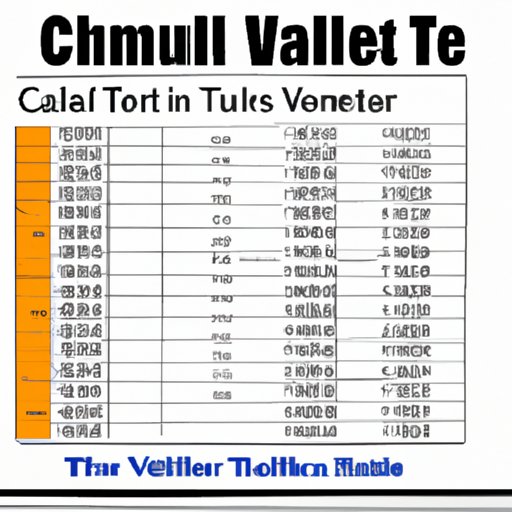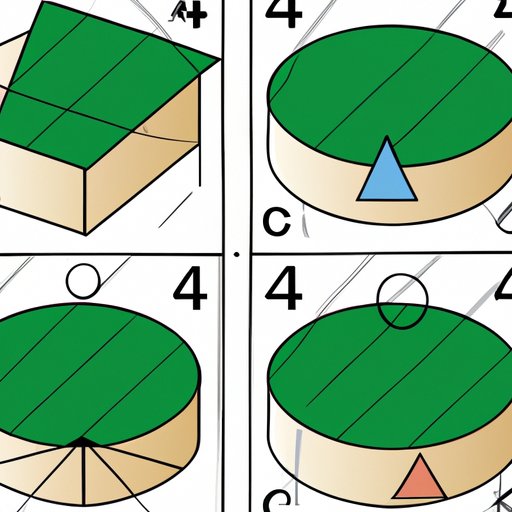Introduction
Volume calculations are an essential part of our daily lives. From cooking to construction, we rely on accurate volume measurements to ensure safety, cost-effectiveness, and efficiency. In this article, we will explore the fundamentals of volume calculations, provide step-by-step guidance, and share tips and tricks to help you master this valuable skill.
10 Simple Steps to Calculate Volume: A Comprehensive Guide
Before we dive into advanced techniques, let’s begin with the basics of volume calculations. Volume measures the amount of space an object or substance occupies in three dimensions. The formula for volume depends on the shape of the object and the units of measurement used.
Here are 10 simple steps to calculate volume:
- Identify the shape of the object.
- Measure the dimensions of the object using the appropriate units (e.g. meters, centimeters, inches, etc.).
- Use the formula for the shape of the object to calculate its volume.
- Round the answer to the appropriate number of significant digits.
- Convert the units of measurement if necessary.
- Label the answer with the correct units of measurement.
- Double-check your calculations to ensure accuracy.
- Record your answer in a clear and organized manner.
- Label any diagrams or illustrations clearly to avoid confusion.
- Practice regularly to improve your speed and accuracy.
For example, to calculate the volume of a cube with side length 5 cm, use the formula:
Volume of a Cube = side length x side length x side length = 5 cm x 5 cm x 5 cm = 125 cm³
Remember to write the units of measurement, cubic centimeters, when recording your answer. Also, it is essential to double-check your calculations, as a small error can result in an inaccurate answer.
Some common mistakes to avoid when calculating volume include:
- Using the wrong formula for the shape of the object
- Using the wrong units of measurement
- Forgetting to convert units of measurement when necessary
- Forgetting to label the answer with the correct units of measurement
- Not rounding the answer to the appropriate number of significant digits
Mastering Volume Calculations: Tips and Tricks
Once you have mastered the basics, you can try some advanced techniques for volume calculations. These techniques are useful for complex shapes and irregular objects. One such technique is integration, which involves dividing the object into infinitesimal volumes and adding them up to find the total volume. Another technique is approximations, which involves breaking the object into simpler shapes and calculating their volumes separately.
As an example, let’s consider the volume of a cone with base radius 5 cm and height 10 cm. You can use the formula:
Volume of a Cone = 1/3 x π x base radius² x height
However, if you want to use integration, you can imagine the cone as a stack of thin disks of radius r and height dx. The volume of each disk is π x r² x dx. By integrating over the entire height of the cone, you can find the total volume.
Other tips for mastering volume calculations include:
- Breaking complex shapes into simpler shapes
- Using symmetry to your advantage
- Using the appropriate mathematical tools and formulas
- Practicing by solving challenging problems

The Ultimate Cheat Sheet for Volume Calculations
If you need a quick reference for volume formulas and unit conversions, here is a handy cheat sheet:
| Shape | Formula | Units of Volume |
|---|---|---|
| Rectangular Prism | length x width x height | cubic units |
| Cube | side length x side length x side length | cubic units |
| Cylinder | π x radius² x height | cubic units |
| Sphere | 4/3 x π x radius³ | cubic units |
Remember, it is essential to always label your answer with the correct units of measurement. Also, when converting units of measurement, make sure to use the appropriate conversion factors.
The Fundamentals of Calculating Volume in Math and Science
Volume is a crucial concept in various fields of study, such as physics, chemistry, and engineering. In physics, volume is used to calculate the density of objects, which is an essential property for understanding their behavior. In chemistry, volume is used to measure the amount of compounds involved in reactions. In engineering, volume is used to design and construct buildings, roads, and other infrastructure.
When calculating volume in math and science, it is essential to use the appropriate units of measurement. For example, in physics, the SI unit of volume is the cubic meter, while in chemistry, the milliliter is often used. Units also play a vital role in conversions between different systems of measurement, which are common in scientific experiments.
Moreover, understanding the relationship between volume and other geometric concepts, such as area and perimeter, can help in problem-solving and real-life applications.
Volume Calculation Methods Every Student Should Know
Aside from the conventional calculation methods, other techniques can make volume calculations easier, especially in real-life scenarios. Displacement method involves submerging the object in a liquid and measuring the amount of liquid displaced. The difference between the initial and final volume measurements gives the volume of the object.
In the case of irregular shapes, the water displacement method is commonly used instead. An object is submerged in a measuring cylinder, and the water displaced is measured. The difference in water volume gives the volume of the object.
It is essential to note that each method has its advantages and disadvantages. For instance, the displacement method requires a significant amount of liquid and may not be feasible for large objects. The water displacement method, on the other hand, is more accurate but may be more time-consuming.
Knowing the different volume calculation methods can be helpful in real-life situations. For example, cooks can use the displacement method to measure the volume of liquids, while gardeners can use the water displacement method to determine the volume of soil in a pot.
A Visual Guide to Understanding Volume Calculations
Visual aids such as diagrams, graphs, and other illustrations can make volume calculations easier to understand and visualize. For example, a diagram of a cone can illustrate how the volume formula is derived from the shape’s dimensions. A bar graph can show the effect of changing the dimensions of a rectangular prism on its volume.
When using visual aids in volume calculations, it is essential to know how to read and interpret them correctly. For instance, a diagram may use different scales for each dimension to emphasize certain features of the shape. Reading and interpreting the scales correctly can prevent errors in calculations.
Also, using visual aids in volume problem-solving can help you understand the problem better and find a more efficient solution. For example, a bar graph showing the volume of water in a container over time can help you visualize how the water level changes and how much water is in the container at a given time.
The Importance of Understanding Volume Calculations in Real Life Scenarios
Volume calculations are not just for math and science classes. They are essential in daily life, such as cooking, construction, landscaping, and more. For instance, miscalculating the volume of ingredients can result in a disastorous dish or, worse, a fire. In construction, miscalculating the volume of materials can lead to wastage, delays, and safety hazards. In landscaping, miscalculating the volume of soil or mulch can lead to extra costs and time spent.
Mastering volume calculations can help you avoid these problems and ensure safety, efficiency, and cost-effectiveness in your daily life. It can also open up many opportunities in various fields of study and industries.
Conclusion
In conclusion, volume calculations are an essential skill that can benefit you in various aspects of your life. By mastering the 10 simple steps, advanced techniques, and volume calculation methods, you can ensure accuracy, efficiency, and safety in your projects and endeavors. Remember to always double-check your calculations, use the appropriate units of measurement, label your answers clearly, and practice regularly to enhance your skills.
So, whether you are a student, a professional, or an aspiring cook, start practicing volume calculations today and enjoy the benefits of this valuable skill.
